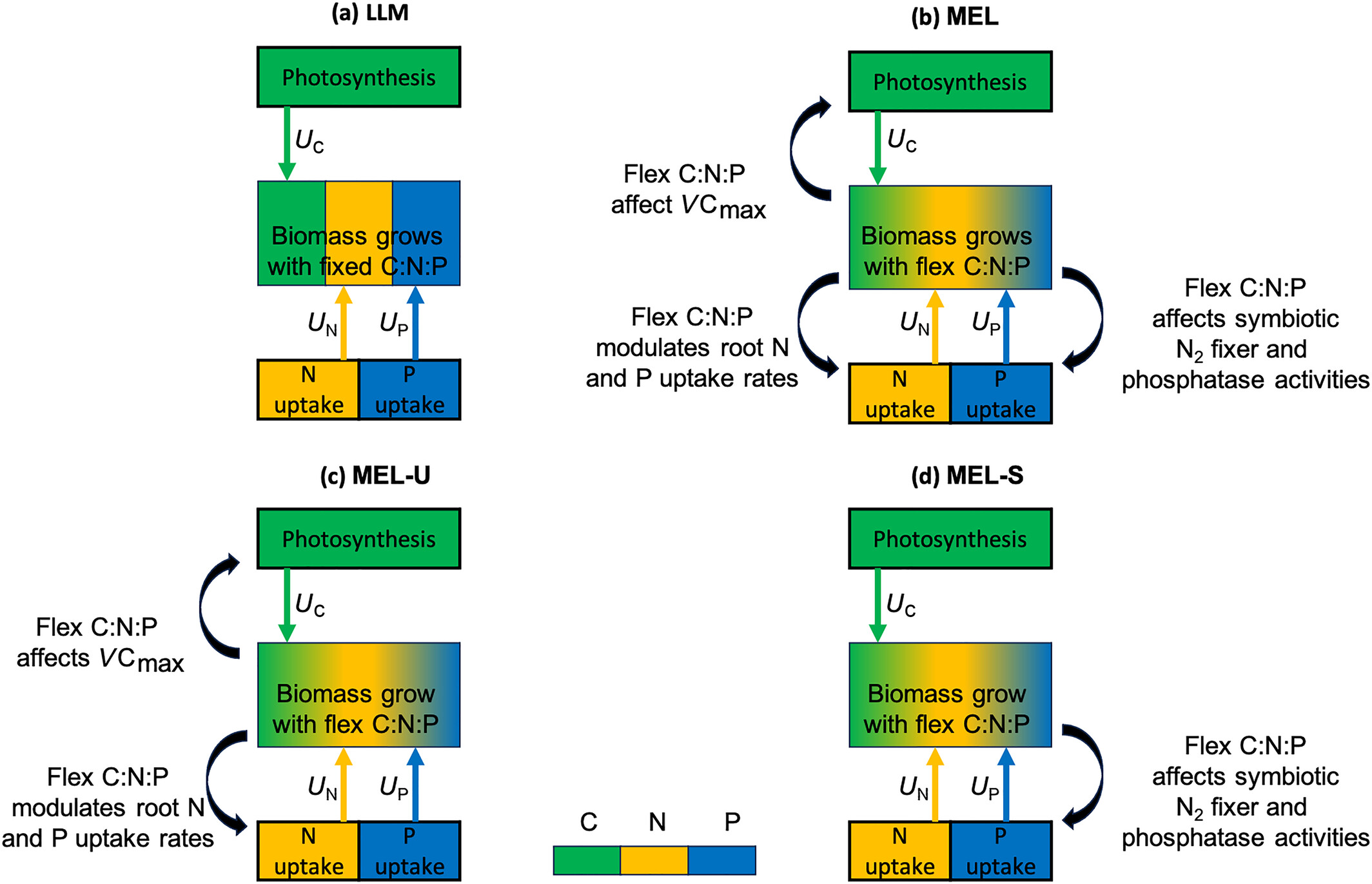Plant responses to elevated CO2 under competing hypotheses of nitrogen and phosphorus limitations

Figure 1. Conceptual diagrams of the competing hypothesis of (a) Liebig’s Law of the Minimum (LLM); (b) Multiple Element Limitation (MEL); (c) MEL allowing the plant to only mediate photosynthesis and nutrient uptake rates towards optimal C:N:P ratios; and (d) MEL allowing the plant to only mediate external resource supply through adjusting symbiotic N2 fixation and phosphatase activity.
The effect of two approaches to representing Nitrogen and Phosphorus nutrient supply in the future climate were compared.
The Science
The future ecosystem carbon cycle has important implications for biosphere-climate feedback. The magnitude of future plant growth and carbon accumulation depends on plant strategies for nutrient uptake under the stresses of nitrogen (N) versus phosphorus (P) limitations.
Natural terrestrial ecosystem processes, including plant biomass growth and microbial decomposition of soil organic matter, are commonly constrained by the availability of multiple nutrients. It has been widely acknowledged that high latitude ecosystems are more limited by Nitrogen supply, while tropical ecosystems are strongly limited by soil Phosphorus supply. However, model simulated responses of ecosystem dynamics to CO2 and nutrient perturbation remain highly uncertain, raising the question of whether models can accurately predict ecosystem carbon dynamics under future environmental changes.
The Impact
This work bridges the gap between observations and model predictions, and improves the confidence in modeled carbon-climate predictions under a changing climate. Extrapolating the two prevailing nutrient limitation hypotheses (Liebig’s Law of the Minimum (LLM), Multiple Element Limitation (MEL), Fig. 1) to global scales using the E3SM land model, the researchers found that the LLM and MEL significantly differ in predicting the future trajectory of ecosystem carbon accumulation. By the end of the 21st century, LLM and MEL predictions could differ by a factor of two for both vegetation and soil carbon fluxes, with the MEL approach better representing observed plant nutrient limitation strength.
Summary
Two prevailing approaches are widely applied to represent the mechanisms affecting nutrient limitations to plant growth. The LLM states that the more limiting nutrient controls plant growth, and commonly leads to predictions of dramatically dampened ecosystem carbon accumulation over the 21st century. Conversely, the MEL approach recognizes that plants possess multiple pathways to coordinate N and P availability and invest resources to alleviate N or P limitation. In this work, the researchers first compiled field measurements of forest N and P fertilization experiments across tropical, temperate, and boreal forest ecosystems (Fig. 2). They then compared the LLM and MEL modeled responses of net primary production (NPP) to the applied nutrient fertilizations, and analyzed which mechanism provides a more accurate plant growth response. Finally, they evaluated the consequences of applying the two limitation approaches on future global carbon dynamics.
The researchers found that MEL better captured the observed plant responses to nutrient perturbations globally, compared with LLM. Furthermore, LLM and MEL diverged dramatically in responses to elevated CO2 concentrations, leading to a two-fold difference in CO2 fertilization effects on Net Primary Productivity by the end of the 21st century. The larger CO2 fertilization effects indicated by MEL mainly resulted from plant mediation on N and P resource supplies through N2 fixation and phosphatase activities.
This analysis provides quantitative evidence of how different N and P limitation strategies can diversely affect future carbon and nutrient dynamics.
Publication
- Zhu, Qing, William J. Riley, Jinyun Tang, and Nicholas J. Bouskill. 2024. “Plant Responses To Elevated Co2 Under Competing Hypotheses Of Nitrogen And Phosphorus Limitations”. Ecological Applications. Wiley. doi:10.1002/eap.2967.
Funding
- This work was supported by the Earth System Model Development program area of the Department of Energy, Office of Science, Biological and Environmental Research program.Contact
Contact
- Qing Zhu, Lawrence Berkeley National Laboratory
This article is a part of the E3SM “Floating Points” Newsletter, to read the full Newsletter check:



